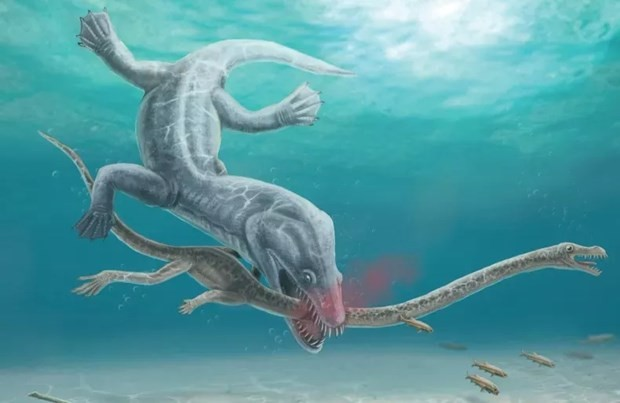Researchers have discovered evidence that a species of long-necked sea "monster" that no longer exists today was due to a fierce attack by another predator.

Studying the fossilized neck and head bones of two species of Tanystropheus, scientists found bite marks like tooth-shaped punctures and other signs of severe and painful trauma. They believe these are signs of neck strangulation.
Previously, when fossil specimens of the Tanystropheus species were discovered, scientists knew that this was a reptile that lived in shallow seas and existed about 242 million years ago. They often hunted fish and squid for food to survive thanks to their strangely long necks that allowed them to ambush their prey from a distance.
Tanystropheus is known in two species, one is a medium-sized species about 6m long, eating fish and squid. The other is a short species about 1.5m long, with teeth like animals that eat mollusks like shrimp.
The neck of the Tanystropheus is usually three times longer than its body. This long neck also makes this species different from any other animal on Earth.
Long necks are a common feature found in fossils of marine reptiles dating back about 175 million years to the time when dinosaurs roamed the Earth. However, long necks have the disadvantage of being easily detected by predators.
According to scientists, the enemy that attacked the long-bodied Tanystropheus could have been a large marine reptile, which scientists believe could have been the 10m-long Cymbospondylus or the 7m-long Nothosaurus. Such "monster" marine reptiles could have bitten the necks of smaller species.
A distant relative of the dinosaurs, Tanystropheus first appeared about 230 million years ago, during the Triassic Period, a time of rapid evolution following mass and widespread extinctions across the planet. It flourished across the Northern Hemisphere for about 10 million years.
According to nhandan.vn
Source link
























![[Photo] Politburo works with Standing Committees of Lang Son and Bac Ninh Provincial Party Committees](https://vphoto.vietnam.vn/thumb/1200x675/vietnam/resource/IMAGE/2025/8/20/0666629afb39421d8e1bd8922a0537e6)

![[Photo] Prime Minister Pham Minh Chinh receives Australian Foreign Minister Penny Wong](https://vphoto.vietnam.vn/thumb/1200x675/vietnam/resource/IMAGE/2025/8/20/f5d413a946444bd2be288d6b700afc33)













































































Comment (0)